Subjects:
- Compression Final Pressure
- Measure compression
- Cylinder Leak Test
- Relative compression test with the oscilloscope
Compression final pressure:
During the compression stroke, the intake and exhaust valves are closed and the piston moves up. The air present (or the air/fuel mixture) is thereby compressed. Once the piston has reached TDC (top dead center), maximum compression pressure is reached. This is called the compression ultimate pressure. As soon as the fuel is added to the air present, the spark plug will spark to ignite the mixture. The combustion pushes the piston down and turns the crankshaft.
The compression final pressure depends, among other things, on the compression ratio.
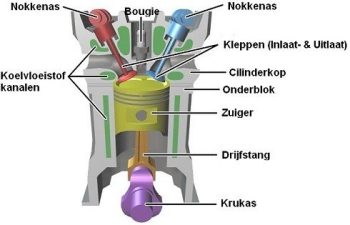
Measure compression:
If the compression final pressure is too low, it will not be possible to extract the maximum achievable energy from the fuel. So, among other things, there is a loss of power. If the final compression pressure of only one cylinder is too low, the engine will shake and vibrate, and in most cases a cylinder misfire fault will be stored.
By measuring the compression, the compression final pressure of the engine can be made clear. A self-registering compression gauge registers the built-up pressure in the cylinder. The technician determines from this pressure whether the final compression pressure is correct.
Step-by-step plan to measure the compression:
1. Make sure the engine is at operating temperature. The engine parts are expanded by the heat, so that the values measured are realistic.
2. Remove the spark plugs.
3. If possible, turn off the fuel supply by removing the connectors from the injectors. The injectors are not activated during starting, so no unburned petrol enters the engine.
4. Insert the compression gauge into the spark plug hole. The rubber end of the compression gauge provides the seal between the gauge and the cylinder head.
5. Have someone else start the engine and keep the accelerator pedal fully depressed. The gas valve opens to the maximum, so that the air drawn in is not choked.
6. While starting the engine, press the compression gauge firmly against the cylinder head. Hissing noises indicate that air is leaking past the compression gauge. As a result, the value on the compression gauge remains too low.
7. After the needle of the compression gauge stops moving further to the right, you can stop starting. Often starting between 3 and 5 seconds is sufficient for a good measurement.
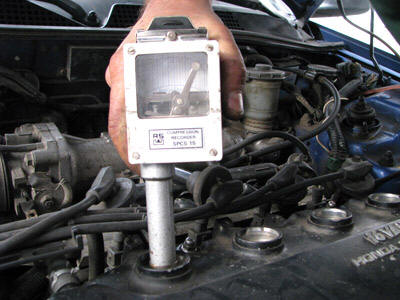
Repeat steps 4 through 7 for each cylinder. When measuring another cylinder, it must be ensured that the measurement is taken on a different part of the card. To do this, click the button on the compression gauge. The card is pushed upwards. Below are a number of situations that occur in practice:
The compression final pressure of all four cylinders is high enough and no cylinder deviates. The measurement indicates that the final compression pressure of the engine is good.
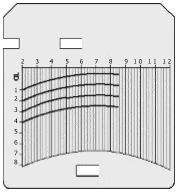
At cylinder 3 the pressure is lower than at the other cylinders. Insufficient pressure is built up in cylinder 3 . This indicates that there is a problem. This could be a problem with the sealing of one or more valves, or a problem with the piston rings.
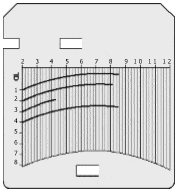
A deviation on two adjacent cylinders indicates that there is probably a crack in the head gasket or the cylinder head between the two cylinders. During the compression stroke of cylinder 2, the air leaks out to cylinder 3 and vice versa.
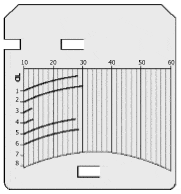
If the compression final pressure of all cylinders is too low, this can have several causes. These can include worn or stuck piston rings.
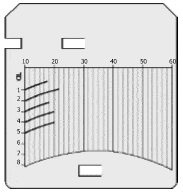
The compression measurement can be used to determine that the final compression pressure is not in order. It is not possible to determine what is causing this. Options for further diagnosis include:
- Pour a little engine oil into the spark plug hole (not too much!). With worn compression springs, the oil will temporarily provide a better seal. A second measurement will therefore be better, or even OK.
- Disassembling engine parts for a visual inspection.
- Performing a cylinder leak test.
Cylinder Leak Test:
A cylinder leak test can identify the cause of the compression loss. With a cylinder leak test, pressure is put in the cylinder space with the help of compressed air. A pressure gauge is connected to the leak tester, which indicates the leakage in percentage. The moment a leak is present, the pressure gauge will show a value greater than 0%. If the air pressure in the combustion chamber remains constant, the meter will indicate 0%. When taking this measurement, make sure that the valves are closed; so carry out the measurement in the situation where the piston is at TDC and is engaged in the compression stroke. When the piston is almost at the top, but is busy with the exhaust or intake stroke, the valve is often already slightly open due to valve overlap. There will then be leakage along the valve, but that is not a defect but a property. If necessary, remove the valve cover to see if the camshaft lugs point upwards.
Step-by-step plan for the cylinder leak test:
- Make sure the engine is at operating temperature. The engine parts are expanded by the heat, so that the values measured are realistic.
- Set the piston of the cylinder being measured to TDC. Make sure the engine is on the compression stroke so that the valves are closed.
- Apply the handbrake and put the car in gear. This prevents the air pressure from pushing the piston down. The car is therefore not allowed to stand on the bridge.
- Apply the compressed air to the cylinder.
- Read the meter.
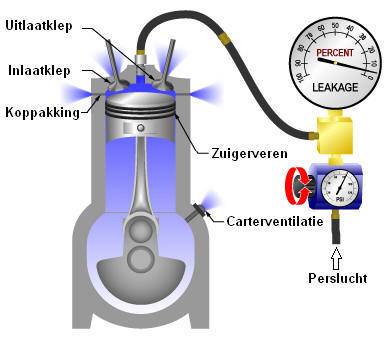
If the meter reads 0%, there is no leakage. Connect the leak tester to the next cylinder. If the meter does show a value, then there is a leak. Because there is compressed air on the cylinder, the air is leaking somewhere. Some possibilities are:
- Blowing noise in air filter intake tube: intake valve leaking
- Blowing sound in exhaust: exhaust valve is leaking.
- Blowing noise after oil filler cap disassembly: air leakage to the oil sump; this can be caused by a defective head gasket or by worn piston rings.
- Blowing noise at cylinder 3 while air pressure is applied to cylinder 2; the head gasket between cylinders 2 and 3 is cracked.
- Air bubbles in cooling system: Cracked head gasket or cylinder head.
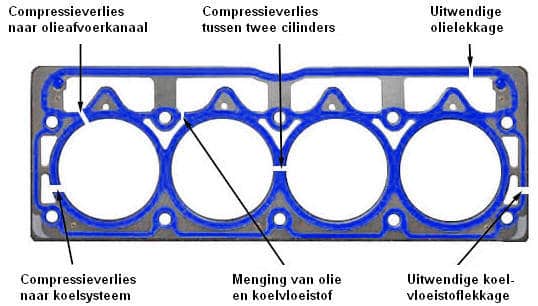
Relative compression test with the oscilloscope:
The compression test can also be done with the oscilloscope be displayed graphically. No engine parts (such as spark plugs) need to be disassembled then. The compression measurement is measured by the amperage of the starter motor. The measurement is taken while the engine is starting, so care must be taken to ensure that the engine does not start. By removing the connectors from the injectors, no fuel will be injected, so the engine will not start. Make sure that not only the ignition is switched off! When only the ignition coils of a petrol engine are disconnected, the engine continues to inject fuel and the fuel will end up directly in the exhaust.
This scope image is of a relative compression test performed on a three-cylinder engine.
The current is shown in relation to the time. The measurement was carried out by connecting the current clamp to the ground cable from the body to the battery and measuring the current generated during starting. Each compression stroke forces the starter motor to make “more effort” to spin. Thus, during the compression stroke, the starter motor will need more power to go around. This can be seen in the peaks of the scope image. If no deviation is visible in the peaks, the result of the relative compression test is sufficient.
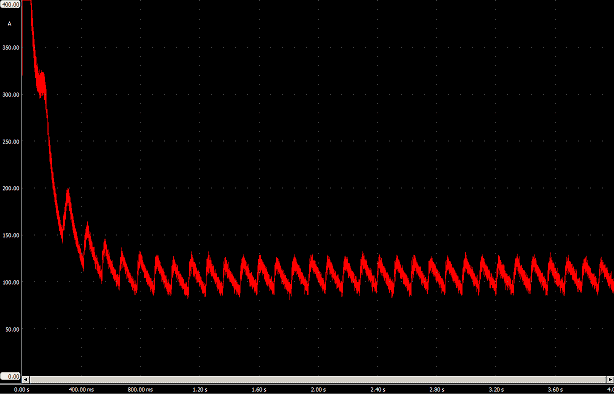
The scope image shown is of a three-cylinder engine where one cylinder has no compression. Compared to the above scope image, it can be seen that one peak is not imaged. The image shows loss of compression. There is a peak high (cylinder 3), a peak low (cylinder 2) and a peak between high and low (cylinder 1). The lowest peak (of cylinder 2) indicates that this cylinder has too low a compression final pressure. The starter motor needs to make less effort on that compression stroke to turn the crankshaft. The medium peak is also caused by that cylinder where compression loss is present, but it does not have to be the case that compression loss is also present in this cylinder. This is explained below on the basis of the drawing:
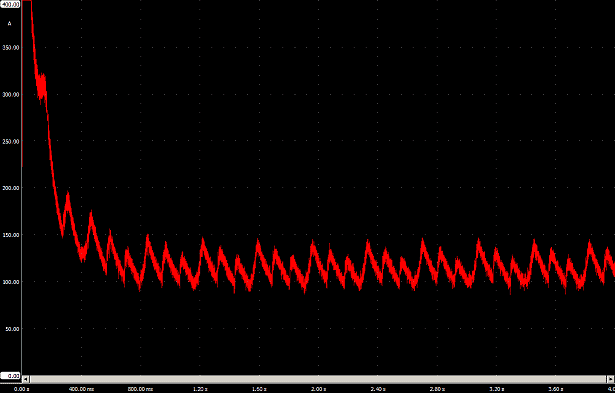
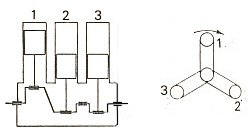
Because the firing order of cylinders 2 and 1 follow each other (firing order 1-3-2), the compression loss on cylinder 2 also affects the scope image of cylinder 1. While moving the piston of cylinder 2 up (and the starter motor due to the compression loss less effort), the piston of cylinder 1 also begins to move upwards.
Without loss of compression, the crankshaft rotational speed will decrease during each compression stroke. However, because the rotational speed on cylinder 2 has not dropped that much, that also affects the crankshaft rotational speed of cylinder 1.
With the scope images above it can be seen whether the engine is in good condition. If all peaks are equal, the relative compression test is OK. In the event of a deviation, these scope images cannot determine which cylinder is the cause. To determine this, an ignition measurement can be performed with channel B. This channel can be displayed in the same screen. The scope image of the ignition will be above the line of the compression reading, identifying the correct cylinder.
